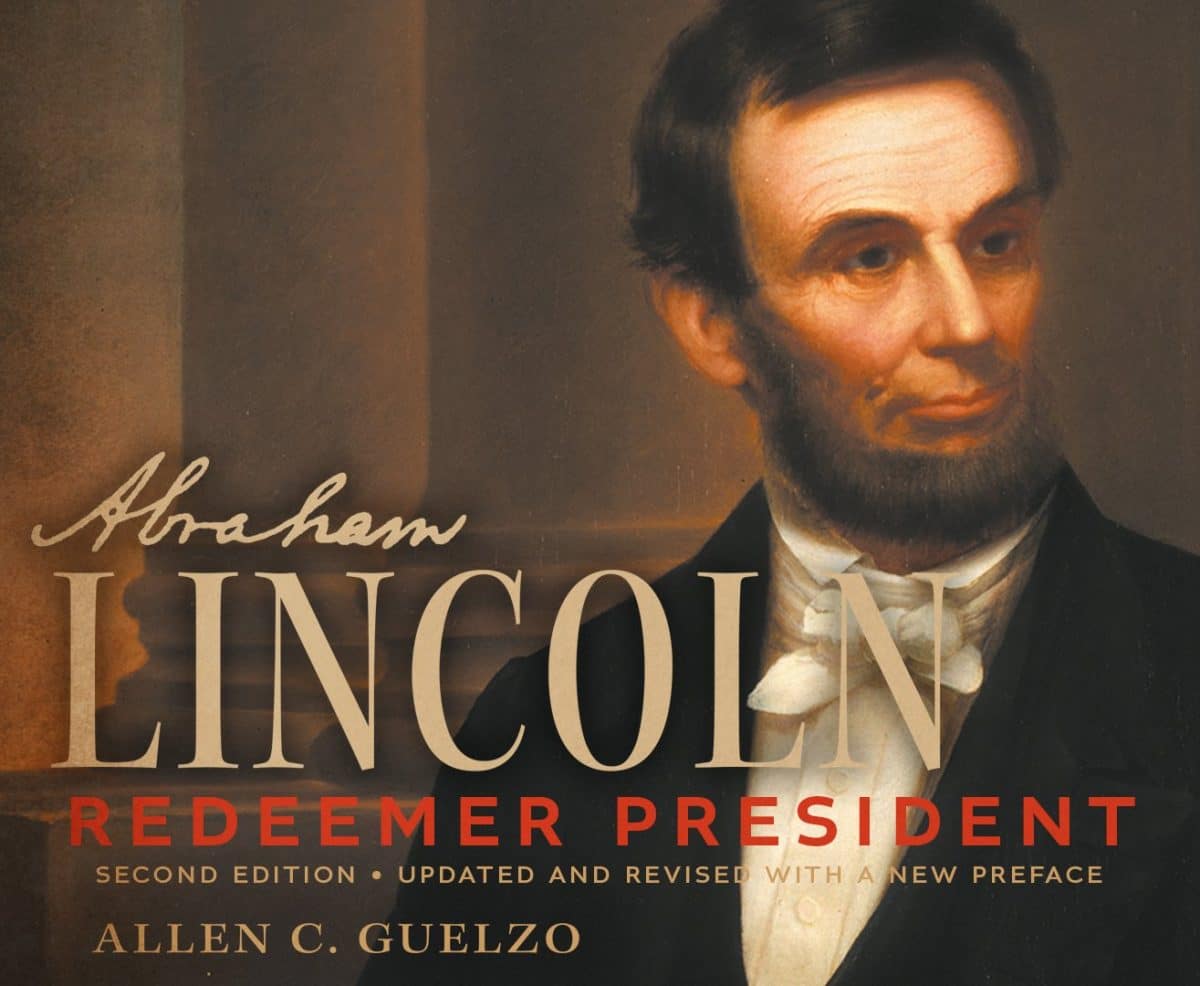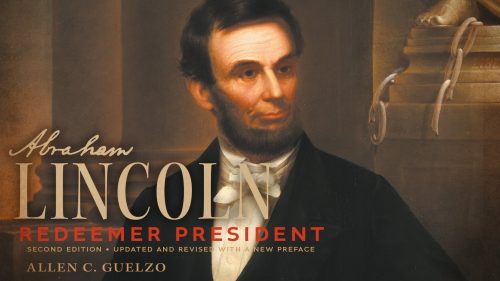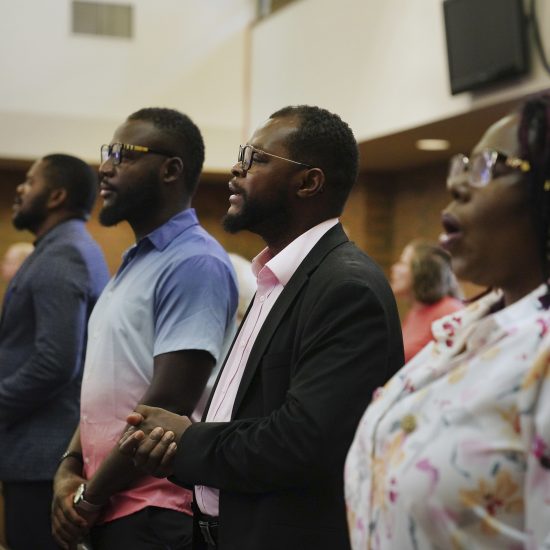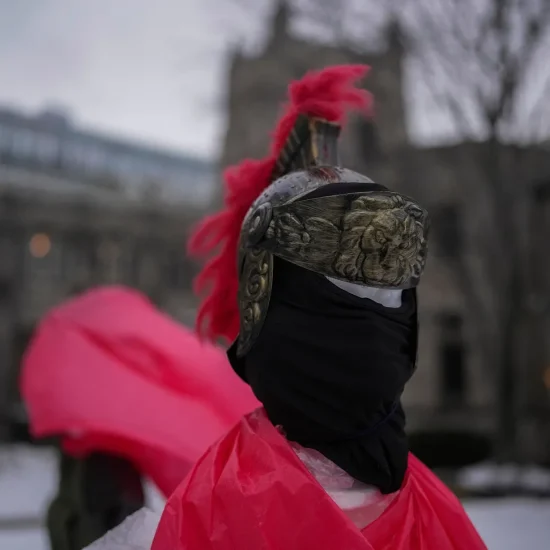

ABRAHAM LINCOLN: Redeemer President. Second Edition. Updated and Revised with a New Preface. (Library of Religious Biography). By Allen C. Guelzo. Grand Rapids, MI: Wm. B. Eerdmans Publishing Company, 2022. Xxv + 508 pages.
Over the course of American history, there have been few truly great Presidents. Most of the men (and I mean men) have been rather mediocre at best. Despite the overall mediocrity of America’s premier leaders, a few Presidents have risen to the top. When they have done so it’s often because they took office during crisis moments and responded well. We might not always agree with their actions, but they demonstrated true leadership. While George Washington is numbered among the greats because he was the first to hold the office, we can count just a few more as truly remarkable. These figures include Thomas Jefferson, Andrew Jackson, and the two Roosevelts. While Jefferson and Jackson have problematic legacies, they were strong leaders who set the course of the nation for a time. Among the Presidents who served between Andrew Jackson and Theodore Roosevelt, only one person stands out. That person was, of course, Abraham Lincoln.

Robert D. Cornwall
Lincoln, like Washington, carries an almost mythological persona. Many hagiographical biographies have appeared over time that offers Lincoln up as almost superhuman (and that doesn’t include the fictive portrayal of Abraham Lincoln the “Vampire Slayer”). Of course, there have been numerous biographies that have attempted to provide a much more balanced and realistic picture. Not all of these are of the same caliber, but they try to present Lincoln in more human terms.
Among the best portrayals of Lincoln’s life is Allen Guelzo’s Abraham Lincoln: Redeemer President. Guelzo released a second updated edition in 2022, replacing the first edition published in 1999. Since I did not read the first edition, this is my first engagement with Guelzo’s detailed portrayal of Lincoln the thinker, politician, and war-time leader. While this biography was published in Eerdman’s Library of Religious Biography series, this biography doesn’t focus on Lincoln’s religious life, though that is present. Instead, Guelzo has written an intellectual biography of Lincoln (the author makes it clear upfront that when approached by Eerdmans to write a biography for the series he insisted that he focus more broadly on Lincoln the thinker than might be expected from a contribution to the series). Guelzo notes that he was reluctant to write about Lincoln for a series focusing on religious biography because most books covering Lincoln and religion have not been very good and have tended to sink the reputation of the authors of those books “into the quicksand of academic obloquy.” Not wanting to fall victim to that problem, he agreed to write the biography with the stipulation that it would be an intellectual biography that located “Lincoln on the larger map of American religion and liberal democratic political theory in the nineteenth century” (p. xi). Since I did not read the first 1999 edition, I can’t determine the degree to which Guelzo has revised this edition. So, for my part, I am reviewing the book as if it is a brand-new contribution.
The author of this biography, Allen Guelzo, is a senior research scholar in the Council of Humanities at Princeton University. He is the director of the Initiative on Politics and Statesmanship for Princeton’s James Madison Program in American Ideals and Institutions. He is also the author of a biography of Robert E. Lee, which I’ve not read. He has written widely on the Civil War, including a book on Gettysburg. I should note that he is also a fellow at the conservative Claremont Institute. While he has more conservative affiliations, as a biography of Lincoln, this is a balanced account. I am surprised, however, that he makes no mention in his account of sources of Ronald White’s excellent biography of Lincoln, especially since both White and Guelzo have a background in American Church History. Whatever his outside relationships, this remains an excellent study of Lincoln’s life.
Since this is an intellectual biography, details about family and other relationships are not front and center. While we learn about his upbringing and eventual marriage to Mary Todd, along with discussions about his children and other family and friendship relationships, these are brought into the conversation when they serve Guelzo’s purpose of exploring Lincoln’s intellectual life. What Guelzo brings into the book are details that help us center Lincoln’s thinking about various dimensions of American political and religious life.
What we learn from Guelzo’s biography is that Lincoln was always eager to learn. He was a voracious reader of many different genres. Interestingly, when it came to his profession as a lawyer, wasn’t all that interested in reading law books. He did so only when necessary for professional reasons. So instead of law books, he read Shakespeare and John Stuart Mill. Politically, Lincoln was an old-school Henry Clay Whig who believed in the superiority of free wage labor and internal improvements. This put him at odds with the Jeffersonian agrarians who were more inclined to support slavery and oppose the extension of the railroads into the western parts of the country. With this as a primary political concern, it shouldn’t surprise us that in the course of his law practice, he represented railroads and that when he served as President, he signed the bill that led to the building of the transcontinental railroad.
While religion isn’t the primary focus of the book, we learn quite a bit about his religious leanings. For example, we learn that Lincoln was brought up by a father who embraced a hard-edged Calvinist predestinarian belief system. While he rejected the Calvinist Baptist tradition of his father, becoming something of a free thinker who appreciated Thomas Paine and John Stuart Mill, those predestinarian roots continued to influence his general belief in providence. This was true even if that belief was naturalistic rather than religious. Nevertheless, it did reflect something of his religious roots. This vision of providence influence his behavior and decision-making as a lawyer, politician, and most of all as a war-time President.
Guelzo’s story of Lincoln begins not with Lincoln’s birth but with the intellectual milieu in which he lived. As I’ve noted, Lincoln was a Henry Clay Whig who, like Clay believed in an activist government that would seek more economic opportunity for a broader portion of society. Therefore, he stood opposed to the southern agrarianism of Jefferson and Jackson that depended on the plantation system (including slavery). At the same time, he was a great believer in the importance of the Declaration of Independence, which served as the foundation of his argument against the extension of slavery. It’s important to remember that Lincoln was not an abolitionist, but he believed that slave labor was inferior to wage labor and that if contained slavery would eventually disappear.
Guelzo points out that Lincoln was born three weeks before Jefferson finished his second term in office. While he lived in Jefferson’s shadow throughout much of his life, the two men had very different value systems. Specifically, Lincoln stood opposed to Jefferson’s patrician values. Instead of patrician landowners, most of whom were slave owners, Lincoln represented middle-class northern and western merchants and professionals. Born on a farm, he didn’t see that life as one to be embraced. In other words, Lincoln was very much the capitalist who embraced middle-class values and believed that southern agrarianism stood in the way of the nation’s progress.
As we move through Lincoln’s life, Guelzo takes us from the farm to life in Springfield, Illinois. It was in Springfield that Lincoln became an attorney and launched his political life. He would serve in the Illinois legislature and in Congress for one term. We learn about the dynamics surrounding his marriage to Mary Todd, whose family he had come to know well in Springfield. We learn about his devoted support to Henry Clay and his loyal support for Whig Presidential candidates besides Henry Clay, including Zachary Taylor.
The first half of the biography takes us up to the eve of Lincoln’s election as President. With this in mind, Guelzo focuses our attention on Lincoln’s famous debates with Stephen Douglas. We learn a bit about nineteenth-century politics, such that while Lincoln won more popular votes than Douglas, the Democratic-controlled legislature chose Douglas instead. This set up a rivalry that would include Lincoln’s run for the presidency. While Lincoln didn’t win the senate seat, his star was rising. With the Democrats divided north and south over how to deal with slavery in the territories, a concern that was exacerbated by Roger Taney’s “Dred Scott” decision, making the possibility of secession quite real, by the time the election occurred in 1860 the Republicans had an excellent chance of taking the Presidency. With the nation and the Democrats divided along north and south sectional lines, as the Republican candidate, he was able to win the election. While he won the election, he inherited a divided nation that was heading toward war.
While Lincoln was a great orator and debater, he had little experience as an administrator. While he had been a legislator, he had never been a manager. Therefore, when he became President, he struggled to manage his administration and deal with the challenges facing him. We’ve heard much about Lincoln’s team of rivals, but what Guelzo reveals is that while there were strong personalities in the Cabinet, representing different viewpoints, Lincoln largely ignored them. He treated these figures, including the former governor of New York, William Seward, as if they were mere department administrators. Thus, he didn’t see them as advisors. Instead, Lincoln largely took his own counsel or that of others he trusted. These advisors were mostly friends from Illinois. So much for the team of rivals.
After South Carolina seceded, a militia laid siege to Fort Sumter. When this militia finally fired on the fort before relief could be brought in support of the beleaguered defenders, Lincoln was faced with the reality that war was inevitable. The challenge that faced him was balancing the positions held by northern non-slave states and the border states who stayed in the union but were still slave states. The border states included Maryland, which provided the northern border of the north-south divide that was emerging. As Guelzo walks us through the story of the Civil War, a story that includes Lincoln’s challenge in finding competent generals willing to fight, we watch as Lincoln’s thinking evolves as well as his grasp of administrative details. As we know from other sources, Lincoln’s priority was reuniting the country. Though he knew that ultimately slavery had to go, ending slavery wasn’t his first priority. It was only later in the war that he came to believe that the nation couldn’t be reunited with slavery still in place. The South wanted to extend slavery into the territories, in part because cotton depleted the land, making extension into new territory necessary. Additionally, the leadership of the Confederacy was committed to fighting for that right, though Lincoln believed (hoped) that the common people who did not own slaves would ultimately rise against the patrician leaders. Unfortunately, sectional loyalties were strong. Thus, emancipation, at least in recaptured territories became necessary and feasible only after the Union started winning battles, especially in the east. Thus, it was only after Antietam that he could move in that direction.
Much of this story is well known, and since this book has a religious dimension, we learn that Lincoln was never a believer. However, while in Washington Lincoln attended New York Avenue Presbyterian Church with Mary. This congregation was served by an old-school Calvinist (of the Charles Hodge type), with whom Lincoln developed a good relationship. While Lincoln never became a believer, as noted earlier, he affirmed the reality of providence and saw himself enveloped by it. In other words, he was something of a fatalist. While he wasn’t a believer, he did believe that religion played a valuable role in public life. Interestingly, the Whigs, unlike the Jeffersonian Democrats, had always embraced religion as an important part of their identity. With that in mind Lincoln called for the appointment of chaplains for the army, something the Democrats had always opposed.
As the story of Lincoln’s life comes to an end, we know that he was assassinated while going to the theater. As Guelzo points out, Lincoln enjoyed the theater (often going unaccompanied by protection—due to his sense of providence). That he was shot while at a theater, posed a problem for some of his hagiographers and evangelical supporters, who disapproved of the theater but saw him as a martyr for a cause. He was the redeemer President, who had died setting people free. Indeed, had he not entered Richmond in triumph on Palm Sunday and died on Good Friday. Despite the problematic nature of his place of death, clergy and other hagiographers found ways of rationalizing the place of his death. As for his death, it was in many ways due to his own fatalism. Whether he lived or died was a matter of providence, and so he tended to go out without escort or seek to evade his escort. That night he went to the theater with only two escorts, and thus John Wilkes Booth found easy access to his box.
In Abraham Lincoln: Redeemer President, Guelzo offers us an important portrait of a man who quickly became more a myth than reality. What we have here is very much a scholarly biography, even if it does not have footnotes/endnotes. However, Guelzo does provide us with “A Note on Sources” that is fairly detailed. Because it is an intellectual biography, it is somewhat dense. One will find very few light stories in this book. While there are descriptions of military campaigns, he doesn’t focus on the battles. Rather it focuses on Lincoln’s thinking about the war and his relationships with allies and foes along the way. In other words, this isn’t a quick read. It will take a degree of diligence to move through it. Nevertheless, it is a worthwhile effort. With so much pseudo-history out there (I’m surprised Eric Metaxas hasn’t written one of his famous faux bios of Lincoln), this should continue to be a standard biography of one of America’s most important political figures.
This review originally appeared on BobCornwall.com.
Robert D. Cornwall is an ordained minister in the Christian Church (Disciples of Christ). Now retired from his ministry at Central Woodward Christian Church (Disciples of Christ) of Troy, Michigan, he serves as Minister-at-Large in Troy. He holds a Ph.D. in Historical Theology from Fuller Theological Seminary and is the author of numerous books including his latest books: Called to Bless: Finding Hope by Reclaiming Our Spiritual Roots (Cascade Books, 2021) and Unfettered Spirit: Spiritual Gifts for the New Great Awakening, 2nd Edition, (Energion Publications, 2021). His blog Ponderings on a Faith Journey can be found at www.bobcornwall.com.






